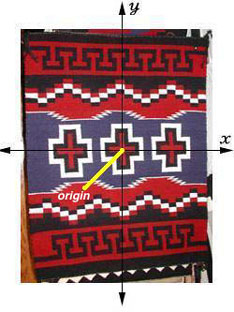Weaving and Geometry
Here are four images of Native American designs. How would you describe them in terms of geometry? What geometric features do they all have in common? Write down your answers, and compare it to your neighbors. Then scroll down to learn more.
Many animals have bodies in which the right half is the mirror image of the left half. That is called "reflection symmetry." Some things have reflection symmetry between top and bottom. Footballs and soup cans, for example, have one shape that is the same for top and bottom, and a different shape that is the same for left and right. If you have the same shape reflected in both directions, it is called "four-fold symmetry."
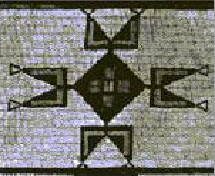
Embroidery, Plains Indians
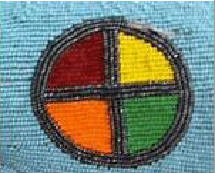
Shoshone Beadwork
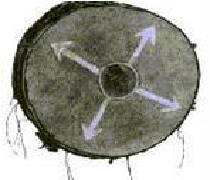
Pawnee Buffalo Hide Drum

Navajo Rug
If we ignore some details, like the color differences in the beadwork example, then all of these designs can be described as having four-fold symmetry. Four-fold symmetry is a deep design theme in many Native American cultures. It is used as an organizing principle for religion, society, and native technology. Many native languages, for example, use base four counting. Teepees are often made with four base poles, each placed in one of the four directions. Prayers are often offered to "the four winds."
Iteration
Navajo rug designs are often visualized early in the process of weaving. By creating basic shapes and repeating them throughout the rug, a process called iteration, a consistent pattern can be formed. A lot of times, these iterative patterns display reflection symmetry and four-fold symmetry. Elements of asymmetry are sometimes present in Navajo rugs as well, but that is always done on purpose.
Looking at the rug designs below, how many instances of symmetry do you see?

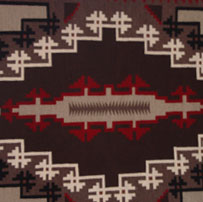
Cartesian Graph
Navajo sand painting offers many good examples of four-fold symmetry. These are used in healing ceremonies. A medicine man ("hataalii") completes the drawing in one day, using colored powder such as crushed stone. The painting is brushed away later that night, along with the illness.
In the Navajo religion, the hataalii heals through the balance of forces. Sand paintings often use reflection symmetry to show these paired forces. Some of these structures are similar to a Cartesian graph. Navajo tradition does not permit photos of sand paintings, so at right we have shown a Navajo rug based on a sand painting. Here we see four human figures. Figures on the horizontal axis are hunched over with back packs. Those on the vertical axis have straight backs. As a Cartesian graph:
+X = Right-side up figure with backpack
-X = Upside-down figure with backpack
+Y = White straight figure
-Y = Dark straight figure
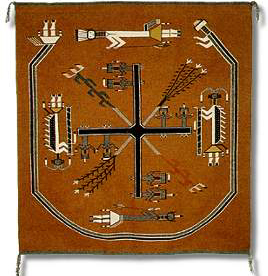
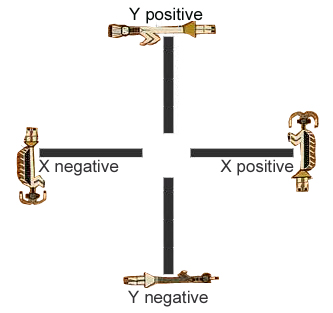
Cartesian Coordinates
Another example in which native design is similar to the Cartesian coordinate system is in Yupik parka decoration. According to Claudette Bradley, professor of education at University of Alaska, the Yupik ("YOU-pick" -- one of the groups called "Eskimos") say it is important to have both sides looking exactly the same (reflection symmetry again!).
So they developed a coordinate system, measuring vertical and horizontal distance on the parka using the width of two fingers as the unit of length.
The center of the coordinate system is near the belly button. Why might that be?
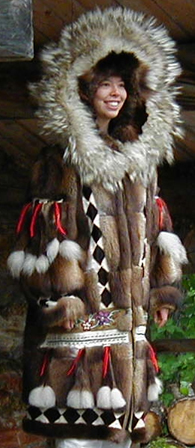

Locating Points
Cartesian Coordinates are used every day in GPS and mapping applications to find specific points on the globe. Instead of describing these points on an X and Y axis, these are instead called Latitude and Longitude. The map below shows a red marker at a (Latitude, Longitude) of (0,0) - the center point of the globe. To find the latitude and longitude of a different point Click on the map, Drag the red marker, or enter an Address.
1. See if you can locate your current location by moving around the map and zooming in as close as you can. Click to create a blue marker and see the Latitude and Longitude of your position in the first set of boxes below.
2. In the second set of boxes below, enter (X,Y) coordinates of (35.680573, -109.052593) and click "Show Point". Where does this take you on the map?
When you click on the map, move the marker, or enter an address, the latitude (X) and longitude (Y) of the point can be seen in the boxes below:
If you know the latitude (X) and longitude (Y) enter them below and see where the point is on the map:
+ for N Lat or E Long
- for S Lat or W Long.
Weaving Axis
Navajo weaving designs are intricate and defy classification and categorization (due to the fact that they are very personal expressions of the weavers). Since looms are set up so that you have vertical warps and horizontal wefts, however, we can talk about rug designs in terms of Cartesian coordinates.
Even though the rug design on the right is not necessarily typical, the fact that it resembles the cartesian grid on the left allows us to see how the position of any design element on a rug can be described according to a cartesian coordinate relative to the center of the rug, which is like the "origin" of a cartesian grid.
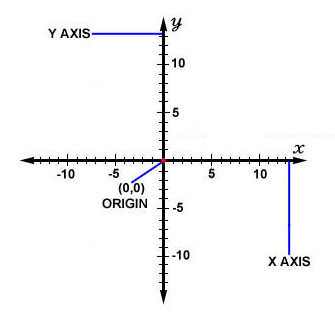

Weaving Coordinates
Before creating the design, the weaver marks two places on the rug (usually using chalk):
1) By counting the weft strands and dividing by two, she finds the horizontal center of the rug.
This is the equivalent of finding X = 0.
2) Using a loose strand of yarn, she determines the total height that the rug will be. She then folds the yarn in half, and uses this measure to mark the vertical center of the rug.
This is the equivalent of finding Y = 0.
Therefore, for the rug on the right, the center of the rug is defined where X = 0 (determined by weft count) and Y = 0 (determined by yarn length), which is the origin on a cartesian grid.
While weaving, the weaver will often count the number of wefts in each design element to ensure that the rug to the right of the horizontal center is an exact reflection of the rug's left side. At the vertical center, the weaver often reflects the design across the X axis. This process of counting to keep track of where design elements are to be placed is crucial for making the rugs symmetrical in appearance.
